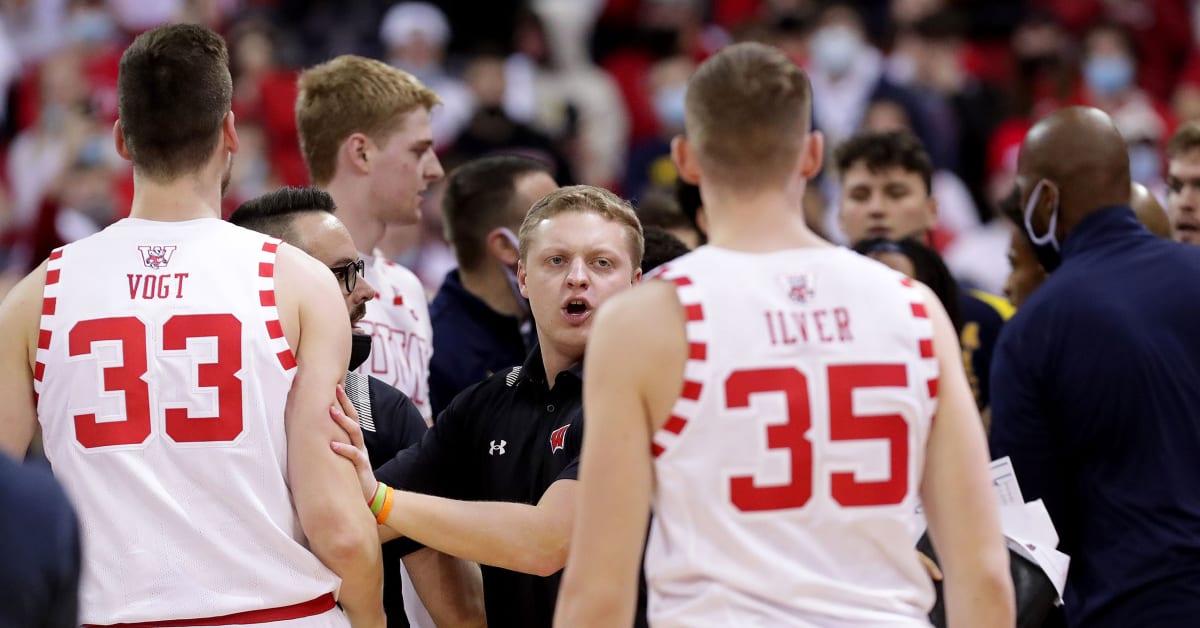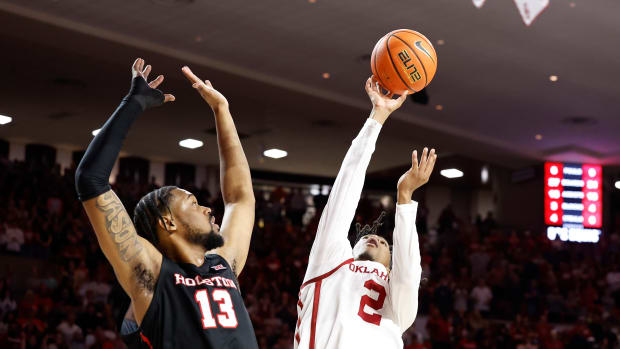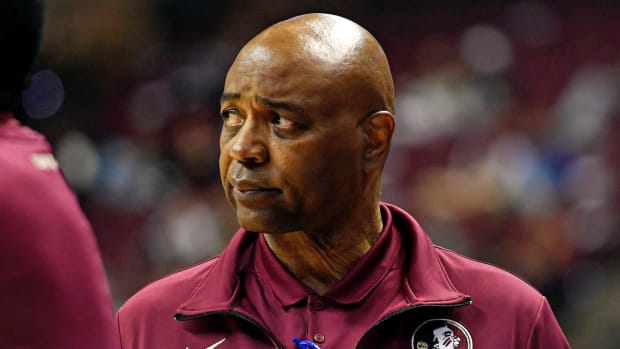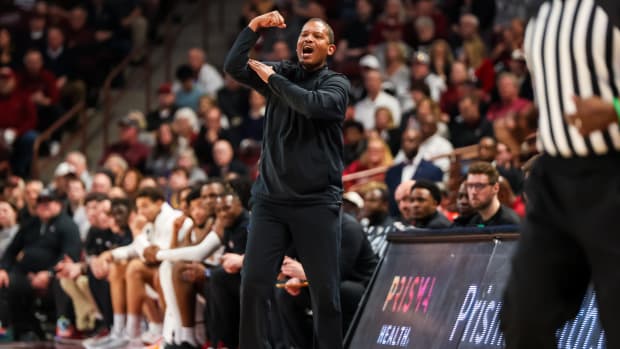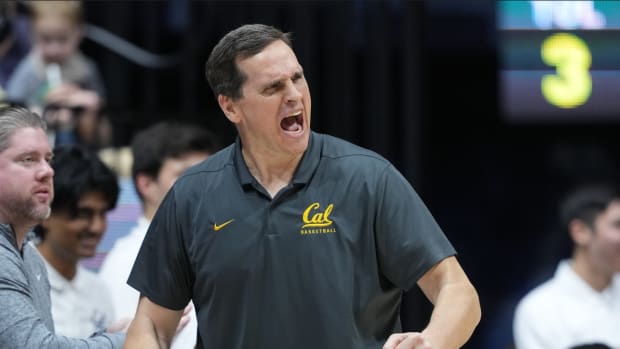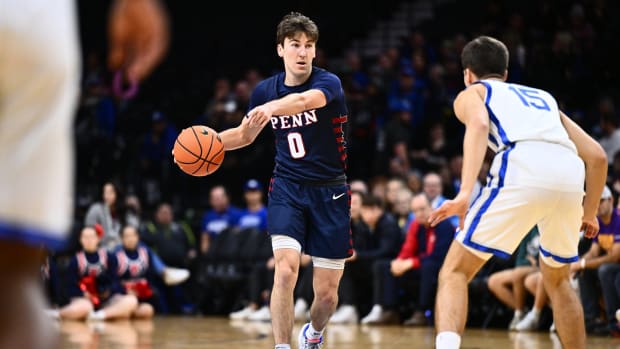Forde Minutes: Ending the Handshake Line Is Not the Answer
Forty names, games, teams and minutiae making news in men’s college basketball, where escalating tempers are a rite of late February:
KEEP THE HANDSHAKE LINE. TELL EVERYONE TO GROW UP.
The ridiculous display at the end of Michigan-Wisconsin (1) on Sunday will undoubtedly lead to another round of calls from some in the media to do away with the postgame handshake line. This is a misguided sentiment that lowers the bar for decorum and waves the white flag of surrender on sportsmanship. If the players and coaches—especially the coaches—cannot make it through a 30-second show of respect to one another without it devolving into a fight, what are we even doing here? Why is that too much to ask?
Learning how to win and lose with some element of grace is one of the essential components of sports. Someone is going to lose every time, right? (Except in sports that tolerate ties, which have their own issues.) Dealing with the outcome of a game is part of competition.

Tempers flared at the end of Sunday’s Wisconsin–Michigan game in Madison.
Mark Hoffman/Milwaukee Journal Sentinel/USA TODAY Network
It’s something that often is taught in youth leagues, although plenty of adults model the opposite for kids by blaming the refs or accusing the other team of lacking class. By college, when everyone involved is considered an adult, behaving like one after the final horn sounds is a baseline expectation. (Then again, it’s now commonplace for social media accounts of the victorious team to insult or lampoon the losers, so we’ve essentially made gloating institutionalized.)
When the millionaire coaches lay hands on each other, they’ve failed a basic principle. And in the case of Michigan coach Juwan Howard (2) on Sunday, he personally escalated a disagreement into a melee. Wisconsin counterpart Greg Gard (3) is not blameless and should not escape sanction, but Howard’s actions led to forceful swings from a couple of his players (and at least one Wisconsin player). They assuredly will face their own suspensions for following the lead of their coach.
Howard’s sideline comportment issues have been documented. But he’s not the only Michigan man who is flunking Handshake 101. Freshman Moussa Diabate (4), one of the Wolverines throwing punches Sunday, had to be restrained during the postgame procedure after Michigan lost at Rutgers on Jan. 4.
The problem isn’t the handshake line. The problem is the people who refuse to hold themselves to a standard of sportsmanship that, frankly, isn’t terribly high. Don’t enable poor losers (and graceless winners) by saying that 30 seconds of mutual respect after a hard-fought game is too difficult a task. If they can do it in the NHL, where the level of physical aggression dwarfs anything on the hardwood, they can do it in college basketball.
THROW OUT THE UNWRITTEN RULES
Part II of the fallout from the semi-brawl in Madison: Howard announced himself displeased with Gard’s late timeout (5) with the game in hand. Gard said he was trying to keep his bench warmers from committing a turnover against Michigan’s pressure defense (6), and several observers pointed out that if Howard didn’t think the Badgers should be calling timeouts, maybe he shouldn’t have been pressing in a game that was over.
Regardless, this is one of the many areas in sports where “unwritten rules” of conduct can take on too large a meaning. Baseball is the worst, of course, but every sport has them—and use of late timeouts is a frequent irritant.
In that instance, The Minutes defers to Minnesota football coach P.J. Fleck, who had this answer when asked about Iowa coach Kirk Ferentz calling three late timeouts in a blowout of the Gophers this past season: “Timeouts are there to be used. That doesn’t affect me one bit. And you know what? We haven’t beat them. So they can do what they want to do.”
It’s a 40-minute game. Play until the final buzzer, then let the fans complain about who conducted themselves properly or improperly at the end.
WHAT IF WE BROUGHT BACK THE END-OF-SEASON PERFORMANCE CRITERIA?
A few years ago, the NCAA men’s basketball committee did away with something that had been part of its selection criteria for a long time—performance down the stretch. How a team did in its last 10 games (or 12) was part of judging its qualifications for making the bracket.
Given the way this season played out, with considerable early tumult due to COVID-19, it would seem like a useful metric to employ. And if it were employed, The Minutes has identified five teams it could greatly help in making the field:
Rutgers (7). Last 10 games: 6–4, but it’s a power-packed 6–4. And it sure as hell was an improvement on a start that included losses to Lafayette, Massachusetts and DePaul. In the last 10, the Scarlet Knights have beaten Illinois, Michigan State, Wisconsin, Ohio State and Iowa. When red-hot Rutgers came into Mackey Arena on Sunday night to face Purdue, it was on a four-game winning streak that had turned a major disappointment of a season into a decent chance at a bid. After the Boilermakers won, coach Matt Painter declared it, “the greatest Quad 2 win in college basketball history.”
Notre Dame (8). Last 10 games: 8–2, with four wins on the road and two defensible losses (Duke and Wake Forest). The Fighting Irish started 4–5. Paradoxically, that start is both the reason they’re on the bubble (despite a 12–4 ACC record), and the reason they’re in contention for a bid—their upset of Kentucky on Dec. 11 looms large amid the early-season dreck. The continually growing role of freshman guard Blake Wesley is a big part of Notre Dame’s late-season surge.
Dayton (9). Last 10 games: 8–2, with wins over fellow tourney aspirants VCU and St. Bonaventure. Like Rutgers, Dayton had a nightmare three-game stretch in November that stains the résumé—losses to UMass Lowell, Lipscomb and Austin Peay, teams with a current combined record of 35–46. Of course, the Flyers also beat Miami, Kansas and Belmont in November, making them the Wild Mood Swing of the Month. With an 11–3 Atlantic-10 record, they’ve done some work to give themselves a chance.
SMU (10). Last 10 games: 8–2, with wins over Houston and Memphis (twice for the latter). Even one of the two losses, at Temple last week, is mitigated by the absence of leading scorer and assist man Kendric Davis. The Mustangs had two bad days in Jacksonville in November, losing to Missouri and Loyola Marymount, but they’re now 19–6 overall and 10–3 in the American.
Virginia (11). Last 10 games: 7–3, including a sweep of Miami and a last-second upset win at Duke, a huge résumé enhancer. Those pair nicely with a November win over Providence that has gotten stronger as the months have gone on. This is by no means a vintage Tony Bennett team—particularly on the defensive end—but it has become better in recent weeks.
And five teams whose tourney standing would be hurt by its performance down the stretch:
Indiana (12). Last 10 games: 4–6, with just one noteworthy win—at home over Purdue. The Hoosiers are on a four-game losing streak heading to Ohio State Monday. Indiana upset the Boilermakers on a game-winning shot by guard Rob Phinisee and he’s missed most of the rest of the season since with a plantar fascia injury. That further thins an underwhelming guard rotation, which has contributed to averaging fewer than 60 points a game during the current losing streak.
LSU (13). Last 10 games: 4–6, with no victories in that span over any sure-fire NCAA tournament teams. Beating Kentucky, Tennessee, Wake Forest, Florida and Belmont in the first half of the season should sew up the Tigers’ bid, but they’ve damaged their seeding with a string of bad losses. This has become a clumsy offensive team, turning over the ball way too often.
BYU (14). Last 10 games: 5–5, with a particularly bad loss at Pacific. The Cougars probably put enough hay in the barn through mid-January to get an at-large bid, but seeding is sliding closer to the edge of the bubble. To feel secure they need to win out at home this week to end the regular season and then not have an early ouster in the West Coast Conference tournament.
Michigan State (15). Last 10 games: 4–6, with a home loss to Northwestern starting the slide. On Jan. 12, the Spartans were 14–2 and 5–0 in the Big Ten. Now they’re all but out of contention for the league title and have a fight on their hands to get back into the top four seeds for the league tournament. The closing stretch of games is brutal.
Oregon (16). Last 10 games: 6–4, which in the Pac-12 is not good enough. After peaking with road wins over UCLA and USC in mid-January, the Ducks have reverted to their pre-Christmas malaise. Being swept by Arizona State is bad; losing at home to California is worse. Oregon needs to win out in the regular season (UCLA and USC come to Eugene this week, then it is at Washington and Washington State) to have any hope of an at-large bid. And it still could be a slim hope.
THE SIX MOST IMPACTFUL FRESHMEN
There are a million players listed as freshmen this season, a COVID-19 accounting trick that will sort itself out eventually. But among those who are legitimately playing their first season of college basketball, the top echelon is really good—and will be really impactful come March. The Minutes looks at the top six:
Chet Holmgren (17), Gonzaga. Some are touting Jabari Smith (see below) as the National Player of the Year, but what if he’s not even the best freshman? Holmgren has been a monster for the Zags, ranking among the national leaders in blocks per game (3.48), rebounds per game (9.6) and field-goal accuracy (62%). He’s also shooting 45% from three-point range—52% in WCC play——and has made at least one three in 12 straight games. There is nobody remotely like him in college hoops.
Jabari Smith (18), Auburn. That’s not to say Smith hasn’t been sensational. He has. He leads the Tigers in scoring (16.3 points per game) and has been on a particularly torrid streak the past two games (59 points, making 11 of 15 three-point attempts). His combination of skill, competitiveness and athleticism is an enticing mix that could make him the No. 1 pick in the draft this summer. But first, maybe Bruce Pearl will make him his No. 1 option at the end of a close game and not watch guard Wendell Green Jr. monopolize the ball. That didn’t work out too well against Florida on Saturday, and it would have been the recipe for disaster if Green had been called for the charge he deserved at the end against Georgia.
Paolo Banchero (19), Duke. Leads the Blue Devils in scoring (16.9) and rebounding (8.4) and is a capable passer as well. (Unlike Holmgren and Smith, Banchero has slightly more assists than turnovers on the season.) As his command and assertiveness grows, there is no column on the stat sheet the 6' 9" Banchero cannot fill.
Blake Wesley (20), Notre Dame. Broke into the starting lineup in December, started to flourish in January, became a star in February. The last three games, the 6' 5" guard averaged 21 points, 4.3 rebounds, three assists and two steals. When the Fighting Irish were teetering on the verge of a bubble-popping home loss to Boston College, Wesley’s fearless drives to the basket kept them alive. Could he be Mike Brey’s first one-and-done pro?
Kennedy Chandler (21), Tennessee. Leads the team in minutes per game (30.2), assists (4.8), steals (2.3) and is just barely behind Santiago Vescovi in scoring (13.2). He’s been versatile enough to slide off the ball and let fellow freshman Zakai Zeigler run the point more often lately, but Chandler’s distributing and defensive intensity remain up to Rick Barnes’s exacting standards.
TyTy Washington Jr. (22), Kentucky. He’s been banged up lately and has watched his more experienced teammates take on the biggest roles in the offense. But Washington has shown flashes of brilliance—28 points in a January blowout of Tennessee, 17 assists against Georgia, a 12-rebound game against Ohio. He’s a determined driver, but also a solid enough perimeter shooter to keep defenses honest.
THE NEMESIS LIST
Every so often, an inferior team somehow has a superior team’s number. Whether it’s matchups or mentality or karma, the better team loses. The Minutes takes stock of a few nemesis situations—some of which have impacted the NCAA tournament bubble:
UNLV (23) is the nemesis of Colorado State. The Runnin’ Rebels are ranked 44 spots below the Rams in the Pomeroy Ratings but have beaten them twice this season by a combined 35 points. The only thing keeping CSU (21–4) from being a mortal lock for the Big Dance at this point are those two losses.
Drake (24) is the nemesis of Loyola Chicago. The Ramblers have lost twice this year to the Bulldogs and three of the last four. The more athletic Bulldogs have forced 34 Loyola turnovers in the two meetings this season, stressing the Ramblers out of their comfort zone. (The two programs also don’t care for each other much, with one of last year’s games ending in a confrontation.)
Florida State (25) is the nemesis of Miami. The Seminoles are just 7–9 in the ACC this season, a rare fall from competitiveness, but they do have a pair of one-point wins over their more accomplished rivals from Coral Gables. The first win this season came on a pair of free throws with less than a second remaining, and the second came on a missed Miami jumper after FSU had given away all but one point of a huge lead. This has been a brutal series for the Hurricanes for years—FSU has now won nine in a row.
Texas Tech (26) is the nemesis of the rest of the state of Texas. First-year coach Mark Adams is 5–0 against the other Big 12 schools from the Lone Star State, sweeping defending national champion Baylor and Texas and looking for the season sweep of TCU on Saturday. The two victories over the Longhorns have been especially sweet for the Red Raiders, given the departure of Chris Beard for Austin last year.
Arizona State (27) is the nemesis of Oregon. As mentioned above, one of the biggest reasons the Ducks are on the wrong side of the bubble at present is two losses to the Sun Devils (10–16, 6–9 in the Pac-12).
Rutgers (28) is the nemesis of Michigan State. The Spartans haven’t just lost consecutive games to the Scarlet Knights across the last two seasons, they’ve been obliterated. Last year, coming off a COVID-19 pause, Michigan State lost in Piscataway by 30 and scored just 37 points. This year, the Spartans were rolled on the road by 21 at a point when Rutgers was coming off a loss to Northwestern and appeared to be in the tank.
Missouri (29) is the nemesis of Alabama in Columbia. This one simply makes no sense. In each of the past three seasons, the Tigers have beaten a better Crimson Tide team in Mizzou Arena—the last two times building big leads and holding on at the end. Last year, the Tigers followed up their upset of Bama by losing seven of their last 10 games; this year they have lost eight of 11 after the big win.
Morehead State (30) is the nemesis of Belmont. The Eagles have won three of the past four, including the 2021 Ohio Valley Conference tournament title game and attendant NCAA bid. The Bruins’ only win in the last four was by a single point in Nashville earlier this month, by the extremely un-Belmont score of 48–47.
IS UPSET SATURDAY LOOMING?
With the selection committee having released its early top 16—subject to major change in the coming weeks, of course—it also sets the table for an intriguing set of games this Saturday. All of the top seven seeds play a dangerous opponent on the road—except for the one that is hosting another top-seven seed. In other words, there could be a shakeup by Sunday morning.
The rundown (all times are ET):
Purdue-Michigan State (31). When: noon. Where: East Lansing. The Boilermakers are a tired team in search of some rest, and the schedule finally provides it this week—they have no games in between beating Rutgers on Sunday and this matchup against the Spartans. With their legs back, will the No. 7 overall seed roll past a Michigan State team that is springing leaks? Or this is an Izzo Special that begins his near-annual rehabilitation of his team for the stretch run?
Kentucky-Arkansas (32). When: 2 p.m. Where: Fayetteville. Bud Walton Arena is back as one of the great venues in the game, and it should be at its zestiest for this visit from the Wildcats, who are the No. 6 overall seed. (Will Eric Musselman (33) keep his shirt on if the Razorbacks win? Maybe, maybe not.) Arkansas’s last two home wins were over Auburn and Tennessee. The Hogs’ only loss since Jan. 8 was by a point on the road at Alabama.
Auburn-Tennessee (34). When: 4 p.m. Where: Knoxville. The Tigers, holding the No. 2 overall seed, have become a vulnerable road team, with losses in their last two games away from home and one-point wins in the two before that. Thompson-Boling Arena is a tough place to get well. Auburn’s high-octane offense will have to execute against Tennessee’s difficult defense.
Kansas-Baylor (35). When: 8 p.m. Where: Waco. This is the matchup of top-six teams, with Kansas at No. 4 and Baylor at No. 5. This has become the big rivalry in the Big 12 in the past two years, with the Jayhawks winning three of the last four—including a blowout in Lawrence earlier this season.
Gonzaga-Saint Mary’s (36). When: 10 p.m. Where: Moraga. The Zags haven’t lost to a WCC opponent since Feb. 22, 2020, and may not lose here. But this is definitely their toughest league game of the year, against a Gaels team that should have an at-large bid locked up at this point.
Arizona-Colorado (37). When: 8 p.m. Where: Boulder. The Buffaloes aren’t great, but they enter this week on a five-game winning streak, and this is always a tricky road game. It’s been especially tricky for the Wildcats, who haven’t won there since 2015.
COACH WHO EARNED HIS COMP CAR THIS WEEK
Mark Adams (38), Texas Tech. It’s always a great week in Lubbock when you beat Baylor and Texas in succession. The Red Raiders did it the way they do most things—with sheer, unstinting effort and a willingness to force the issue in terms of physical play. Tech shot 59 free throws in the two games, to its opponent’s 38. Tech leads the Big 12 in percentage of free throw attempts to field goal attempts during conference play. With those wins and a manageable four-game path to the postseason, the Raiders threw their cowboy hat into contention for earning as high as a No. 2 seed come Selection Sunday.
COACH WHO SHOULD TAKE THE BUS TO WORK
This is Juwan Howard’s award for the week, but since we’ve already mentioned him: save a seat on the bus for Butler’s LaVall Jordan (39). In a span of three days, his Bulldogs lost to St. John’s by 34 and then squandered a 19-point second-half lead at home against Providence. Butler is 13–15 overall, 6–11 in the Big East and trying to avoid its first consecutive losing seasons since 1988–89 and ’89–90.
BUZZER BEATER
The Minutes had grand plans for a good meal on the road Sunday night, but the Michigan–Wisconsin fracas dismantled those hopes. When faced with breaking news, order Door Dash and get a couple of Sierra Nevada (40) Pale Ales at the hotel bar and hope for better next week. Sorry for the letdown.
More College Basketball Coverage:
• Five Takeaways From Men’s Top 16 Reveal
• Michigan AD: There’s ’No Excuse’ for Altercation
• Dickie V Can’t Be Silenced
